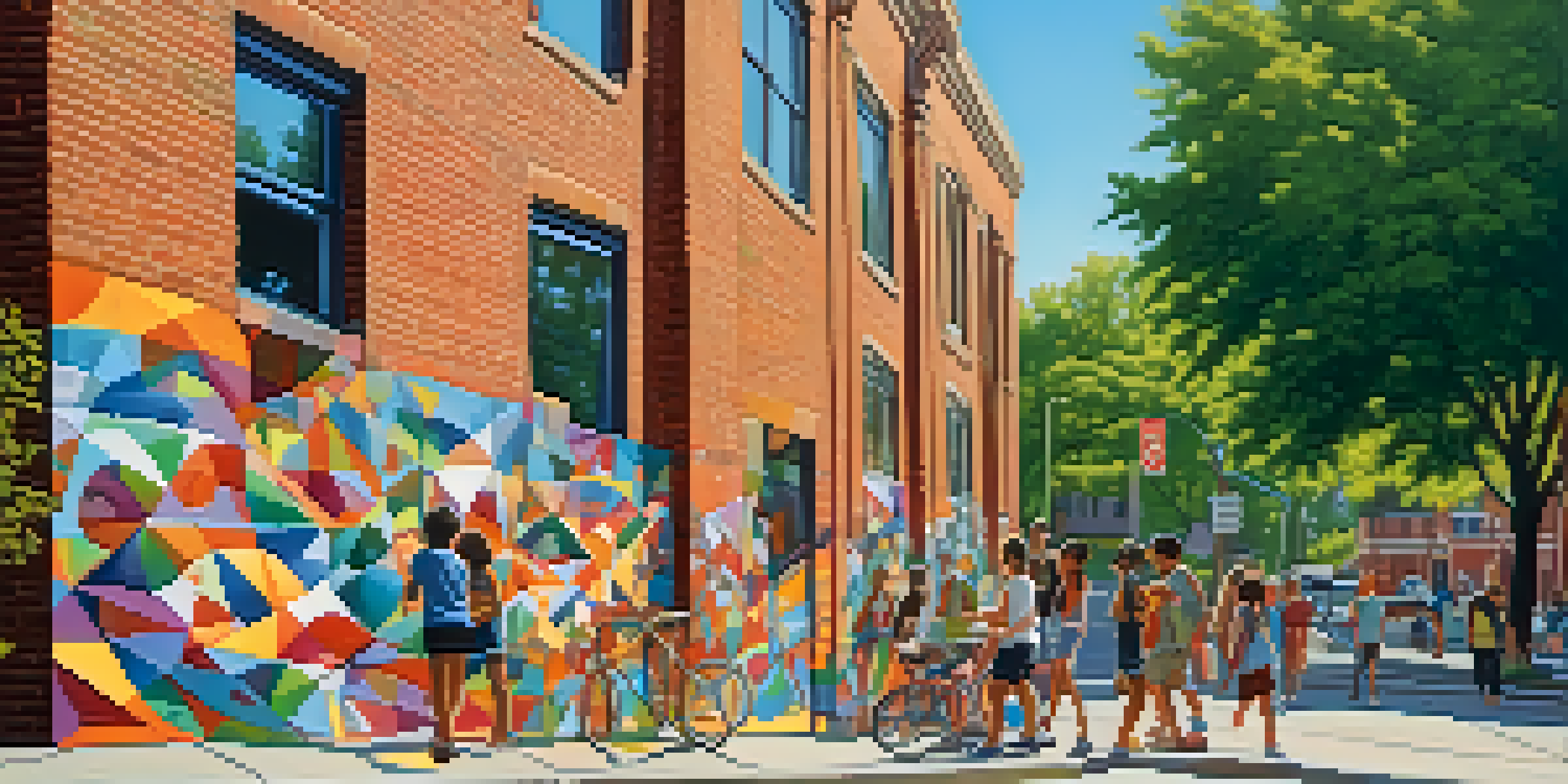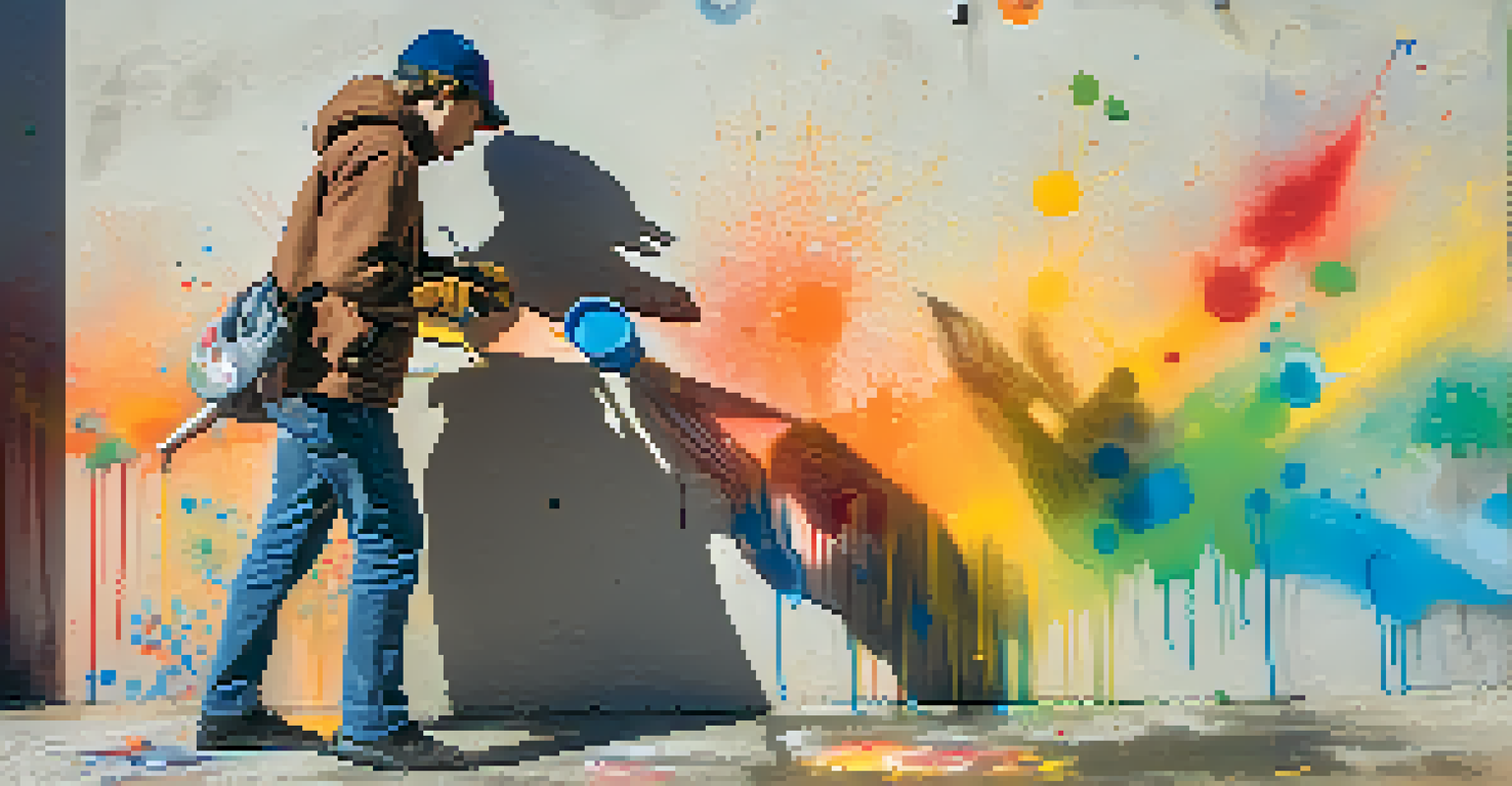Suburban Youth and Art: Expression through Graffiti

The Rise of Graffiti in Suburban Areas
Graffiti has evolved from urban landscapes to suburban neighborhoods, becoming a vibrant form of artistic expression for many youth. In these areas, young artists often find walls as blank canvases, allowing them to share their thoughts and emotions. This shift reflects not only a change in location but also a transformation in the perception of graffiti, from vandalism to a legitimate art form.
Art is not what you see, but what you make others see.
In many suburbs, graffiti is often seen as a way for teenagers to assert their identity and connect with their peers. The bright colors and striking designs can serve as a visual representation of their experiences, frustrations, and dreams. This newfound visibility has encouraged local communities to reconsider how they view these artistic expressions.
Moreover, the rise of social media has amplified this trend, allowing suburban youth to share their work widely and gain recognition. Platforms like Instagram and TikTok have become galleries where young artists can showcase their talent, further blurring the lines between street art and mainstream art culture.
Art as a Form of Communication
For many suburban youth, graffiti serves as a powerful form of communication, conveying messages that might otherwise go unheard. Their artwork often reflects social issues, personal struggles, or community pride, allowing them to voice their thoughts in a visually impactful way. Each piece can tell a story, making the walls of their neighborhoods a canvas for dialogue.

This form of expression can also foster a sense of belonging among youth who feel marginalized or disconnected. By seeing their feelings and experiences reflected in graffiti, they find solidarity with others who share similar struggles. It creates a community where they can express themselves freely and connect with their surroundings.
Graffiti: A Voice for Youth
Graffiti serves as a powerful form of communication for suburban youth, allowing them to express their thoughts on social issues and personal struggles.
Additionally, graffiti can challenge societal norms and provoke conversations about important topics. By using their art to address issues like mental health, inequality, and environmental concerns, these young artists engage their communities in meaningful discussions that often lead to greater awareness and change.
Challenges Faced by Graffiti Artists
Despite its growing acceptance, graffiti artists often face significant challenges, including legal repercussions and community opposition. Many young artists view their work as a legitimate form of art, but local laws often classify it as vandalism, leading to fines or community service. This legal grey area can discourage budding artists from pursuing their passion.
The greatest artists are those who can see the world through the eyes of others.
Moreover, the stigma surrounding graffiti can lead to misunderstandings between artists and their communities. While some residents appreciate the creativity, others may view it as defacement. This division can create tension and make it difficult for young artists to find safe spaces to express themselves freely.
To combat these challenges, some communities are beginning to embrace graffiti as a legitimate art form, offering designated spaces for artists to showcase their talent. Initiatives that promote legal graffiti walls not only provide a safe outlet for expression but also help bridge the gap between artists and residents, fostering understanding and appreciation.
The Role of Community in Supporting Youth Artists
Community support plays a crucial role in nurturing young graffiti artists and validating their work. When adults and local organizations recognize the value of graffiti as a form of expression, they create an environment where youth can thrive. This support can take various forms, including workshops, art shows, and mentorship programs.
Engaging local artists and educators in these initiatives can help bridge the generational gap and foster understanding. By providing opportunities for collaboration, communities can encourage young artists to develop their skills while also learning about the history and techniques of graffiti art. This collaborative approach not only empowers youth but also enriches the local culture.
Community Support is Vital
Local communities play a crucial role in nurturing young graffiti artists by providing resources, mentorship, and designated spaces for expression.
Additionally, community art projects that involve graffiti can help beautify public spaces, turning them into vibrant areas that reflect the collective identity of the neighborhood. When residents see their community transformed through art, it fosters pride and strengthens bonds, creating a shared sense of ownership among all residents.
The Intersection of Technology and Graffiti
In today's digital age, technology has become an essential tool for graffiti artists, allowing them to showcase their work and connect with a wider audience. Many young artists use digital platforms to document their creations, share their processes, and engage with followers. This not only amplifies their voices but also creates opportunities for collaboration and networking.
Social media platforms like Instagram are particularly impactful, enabling artists to reach audiences beyond their local communities. By sharing their work online, they can gain recognition and even attract opportunities for exhibitions or commissions. This exposure can be a game-changer for young artists looking to make a name for themselves.
Furthermore, technology has also influenced the techniques used in graffiti. With the rise of digital art tools and programs, some artists are experimenting with augmented reality (AR) and virtual graffiti, pushing the boundaries of traditional street art. As these innovations continue to evolve, they open new avenues for creativity and expression in the graffiti landscape.
The Future of Graffiti as an Art Form
As graffiti continues to evolve, its status as a legitimate art form is becoming increasingly recognized. Many art institutions are beginning to incorporate graffiti into their exhibitions, showcasing the work of both established and emerging artists. This shift in perception indicates a growing acceptance of graffiti as a vital component of contemporary art.
The future of graffiti will likely see further integration into community projects and urban development. Cities across the world are starting to embrace street art as a means to revitalize neighborhoods, turning neglected spaces into vibrant art hubs. This not only enhances the aesthetic appeal of these areas but also encourages local engagement and tourism.
Technology Shapes Graffiti's Future
The integration of technology, particularly social media, is expanding the reach and recognition of graffiti artists, transforming their work into a broader art form.
Moreover, the dialogue surrounding graffiti is expanding, with more artists advocating for their rights and the preservation of public art. As conversations around the value of graffiti continue to grow, it's clear that this form of expression will play a significant role in shaping the cultural landscape of suburban areas for years to come.
Personal Stories: Voices Behind the Spray Can
Delving into the personal stories of young graffiti artists reveals the deep emotional connections they have with their work. Many artists use graffiti to cope with personal challenges, such as mental health issues or family struggles. Through their art, they find solace and a way to communicate feelings that might otherwise remain unexpressed.
For instance, one artist might share how a particular mural helped them overcome feelings of isolation during a difficult time. By pouring their emotions into their art, they not only create something beautiful but also find healing and connection. These personal narratives highlight the transformative power of graffiti as a tool for self-expression.

These stories also serve to inspire other young artists who may be facing similar challenges. By showcasing the journeys of individuals who have used graffiti to navigate their circumstances, communities can foster a sense of hope and encouragement. Ultimately, the voices behind the spray can remind us of the profound impact that art can have on our lives.